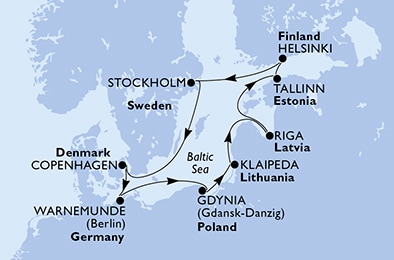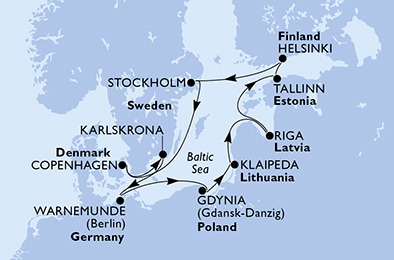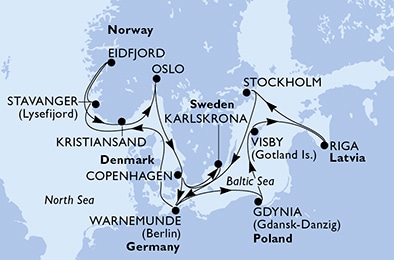
Port Gdynia (Gdansk)
Gdynia and Gdańsk, two vibrant cities on Poland’s northern Baltic coast, offer a blend of modernity, history, and seaside charm. Gdynia, a relatively young city, is known for its maritime focus, featuring attractions like the Dar Pomorza, a historic tall ship, and its scenic Orłowo Cliff. With its lively marina, sandy beaches, and cultural events such as the Open’er Festival, Gdynia is a dynamic destination for both nature and city enthusiasts. Its clean, modern vibe contrasts beautifully with the historic depth of nearby Gdańsk, making it a refreshing coastal hub.
Gdańsk, by contrast, is steeped in history. Its Old Town showcases architectural gems like St. Mary’s Basilica, the Neptune Fountain, and the medieval Gdańsk Crane, reflecting its rich Hanseatic past. The city is also a symbol of resilience, having played a central role in the Solidarity movement, which helped bring an end to communism in Eastern Europe. Visitors can explore this legacy at the European Solidarity Centre. Together, Gdynia’s modern allure and Gdańsk’s historical significance make the Tricity area a unique and captivating destination along Poland’s Baltic coast.
History
Gdynia, located on the Baltic Sea in northern Poland, is a modern port city that emerged as a key symbol of Polish independence. After regaining independence in 1918, Poland needed its own deep-sea port, as nearby Gdańsk was designated a Free City under the League of Nations. Construction of Gdynia began in the early 1920s, and by the 1930s, it had grown into one of the most modern and significant ports on the Baltic Sea. Today, Gdynia is known for its modernist architecture, maritime heritage, and vibrant cultural events, such as the Gdynia Film Festival.
In contrast, Gdańsk boasts a rich history dating back to the 10th century and was a major trading hub in the Hanseatic League during the medieval period. It holds a special place in world history, as the German invasion of Poland began here at Westerplatte on September 1, 1939, marking the start of World War II. Rebuilt after wartime destruction, Gdańsk is also the birthplace of the Solidarity Movement, which played a pivotal role in ending communist rule in Poland. Today, Gdańsk enchants visitors with its beautifully restored Old Town, historic landmarks like Neptune's Fountain, and its significance as a center for culture and resistance. Together, Gdynia and Gdańsk showcase Poland’s maritime legacy and historical resilience.





 With bus transport to the port
With bus transport to the port












